|
|
|
Sort Order |
|
|
|
Items / Page
|
|
|
|
|
|
|
| Srl | Item |
| 1 |
ID:
188014


|
|
|
|
|
| Summary/Abstract |
This article looks at the linkage between arms smuggling and terrorist groups operating in and outside India, focusing on inflow and outflow of weapons through the country. By examining various news reports and using information from security officials, it concludes that the nexus between arms smugglers and terrorists encompasses multiple fronts. These include weapons that enter India mainly from Pakistan, Myanmar, and Bangladesh. Using theories of insurgencies as a reference point, it analyzes how various terrorist/insurgent groups in India have sustained themselves logistically using these linkages to wage war against the Indian state. The article thus tries to tackle the under-researched nexus between arms proliferation and terrorism in India and abroad by providing national, socioeconomic, and political recommendations, a useful reference point for members from the government, security, and research community.
|
|
|
|
|
|
|
|
|
|
|
|
|
|
|
|
| 2 |
ID:
188017
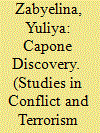

|
|
|
|
|
| Summary/Abstract |
This article analyzes extortion by terrorist groups. A three-factor theoretical framework borrowed from the literature on organized crime informs the qualitative analysis of several terrorist organizations—active and quiescent—which have committed casual and systematic extortion of businesses and local communities in exchange for protection. It is argued that similarly to organized crime, extortion is a common means of terrorism financing. Terrorist groups, especially those aspiring for statehood, rely on extortion of local communities and businesses under the disguise of “taxation.” Partly by coercion and partly by manipulation, governance-capable terrorist organizations, like the Islamic State in Iraq and the Levant (ISIL)/Da’esh, have demonstrated unprecedented ability to reshape the victim-offender relationship in the way that transforms victims of extortion into involuntary terrorist supporters. Viewing terrorist activity through the governance perspective sheds new light on the evolution of extortion and its place in terrorism studies.
|
|
|
|
|
|
|
|
|
|
|
|
|
|
|
|
| 3 |
ID:
188016
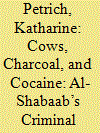

|
|
|
|
|
| Summary/Abstract |
Contrary to historical terrorism scholarship, terrorist groups can strategically diversify into a variety of criminal activities without losing their core ideology or support among the civilian population. This pattern is demonstrated by the evolutionary arc of al-Shabaab, which grew from a small subset of Somalia’s Islamic Courts Union to the most violent political actor in the Horn of Africa, able to conduct terrorist attacks as far afield as Kenya, Djibouti, and Ethiopia. Al-Shabaab has been highly successful in creating a narrative of truth and justice provision while simultaneously exploiting the Somali population and engaging in criminal activity. For the group, criminal activity and crime networks serve two primary purposes: as a funding mechanism and as an avenue for recruitment. Using ethnographic fieldwork and process tracing, I find that the group’s criminal activities throughout the Horn of Africa have made the group significantly more resilient to counterterrorism and counterinsurgency campaigns, extending both its lifespan and operational capability.
|
|
|
|
|
|
|
|
|
|
|
|
|
|
|
|
| 4 |
ID:
188011
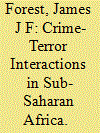

|
|
|
|
|
| Summary/Abstract |
Interactions between criminal and terrorist networks in sub-Saharan Africa (and elsewhere) are frequently based on a complex mix of intentions, capabilities, opportunities and precipitant conditions found in their operating environment. Understanding these interactions, and responding accordingly, thus requires a complex, multi-dimensional analysis that draws from several academic disciplines. This article begins by reviewing several contemporary examples of organized criminal and terrorist activity in sub-Saharan Africa, as well as examples of crime-terror interactions in this region. Then the discussion turns to examine several contextual influences (trends and conditions) that contribute to these contemporary examples and provide ample reasons why we should anticipate future crime-terror interactions in Africa for many years ahead. Research and policy implications that flow from these observations are also provided in the conclusion.
|
|
|
|
|
|
|
|
|
|
|
|
|
|
|
|
| 5 |
ID:
188019


|
|
|
|
|
| Summary/Abstract |
Terrorist organizations increasingly resort to the Internet to promote terrorism, recruit new terrorists, plan and finance their operations. The paper first proposes a definition of terrorism, cyberterrorism, and online terrorism preparatory acts. It then analyses whether current binding international instruments on terrorism, organized crime or cybercrime could prohibit cyber activities precursor of terrorism. The paper concludes that there is no gap in international law that leaves online terrorism related acts completely unregulated. It nevertheless recommends the drafting of an international treaty that would respond more comprehensively, precisely and thus efficiently to the use of the Internet for terrorist purposes.
|
|
|
|
|
|
|
|
|
|
|
|
|
|
|
|
| 6 |
ID:
188015
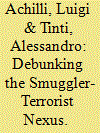

|
|
|
|
|
| Summary/Abstract |
Amid increasing terrorist violence in and beyond European countries, concerns have been raised about connections between illegal migration and terrorism. Regional armed conflicts in the Middle East have led to the massive migration of people in search of safe heavens and better livelihoods, pressing upon frontline countries in the Mediterranean and throughout the EU. Multiple government and intelligence agencies report that human smuggling networks have been identified as providing a readily available conduit through which terrorist groups such as the Islamic State and Al-Qaida can enter Europe and the U.S. These criminal travel networks are said to rely on highly effective transnational alliances involving service providers within source, transit and destination countries. There is also widespread consensus in the intelligence circles that terrorist groups rely on the practice of smuggling for financing of terrorist activity. Nonetheless, despite the region’s geopolitical significance and its demonstrated potential for spillover effects, scant systematic field research has been conducted by independent researchers to understand the purported nexus between terrorism and human smugglers within the Middle East into the Mediterranean. This constitutes a severe gap in knowledge which our study will address. In this paper, we debunk the nexus human smuggling-terrorism by comparing the Islamic State’s logistics with human smuggling networks’ modus operandi and organizational structures. Based on a mixed research approach that combines the analysis of a unique date-set (U.S. Special Forces) and an empirical research carried out among smugglers and migrants in the Middle East and across the Eastern Mediterranean route over the past two years, this paper will tackle the alleged connection between human smuggling and terrorist groups. What will be argued is that smuggling networks and terrorist networks have fundamental operational and structural differences. These operational and structural differences need to be taken into account in order to deconstruct harmful stereotypes on irregular migration and, consequently, develop adequate responses to analytically distinct phenomena.
|
|
|
|
|
|
|
|
|
|
|
|
|
|
|
|
| 7 |
ID:
188013


|
|
|
|
|
| Summary/Abstract |
This paper aims at building from existing sociological, economic, political and strategic knowledge an analysis that anticipates the emergence of the Mafia. By employing Mill’s method of agreement, the research finds that it is very probable that the aftermath of the Syrian War yields fertile terrain for the emergence of the Mafia. The reasons of this are fourfold: (1) as the black market expands in Syria and the rights of private property become blurred once ‘peace’ is restored, (2) the postwar Syrian State will be either unwilling and unable to protect the property rights of its population, (3) this situation would result in a widespread institutional distrust that will provoke the population to seek alternative forms of private protection; (4) an abundant supply of insurgents and terrorists trained in violence will meet the emergent demand. This conclusion sheds light on the importance for policymakers to take prompt action to change the probable course of history of Syria.
|
|
|
|
|
|
|
|
|
|
|
|
|
|
|
|
| 8 |
ID:
188004
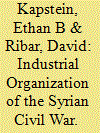

|
|
|
|
|
| Summary/Abstract |
The Syrian Civil War represents an extreme outlier in terms of the number of insurgent groups which have been engaged in the fighting. These groups have also been remarkably persistent over time, partly due to the fact that rebel in-fighting has been relatively contained. They have also targeted civilians far less than the Syrian Army. These stylized facts run counter to much of the existing literature on multi-party civil wars, which has emphasized the influence of the balance of power on group dynamics. In this article we instead draw upon balance of threat theory, along with insights from the economics of industrial organization, to understand insurgent behavior in the Syrian Civil War, based on a newly compiled dataset of rebel violence. Our research suggests that conflict scholars need to account for factors beyond the balance of power if they are to adequately explain inter-rebel dynamics.
|
|
|
|
|
|
|
|
|
|
|
|
|
|
|
|
| 9 |
ID:
188012


|
|
|
|
|
| Summary/Abstract |
One of the most important legacies of the “Troubles” in Northern Ireland and the ensuing 20 years post-peace-process era, heralded by the 1998 Good Friday Agreement, is the rise of complex and diverse Republican and Loyalist paramilitary groups engaging in acts of terrorism and a wide range of organized criminal and cross-border activities. Yet, little scholarship has been dedicated for examining the nexus between terrorism and organized crime in Northern Ireland or for accurately understanding the role that paramilitaries play in organized crime and their dynamic interactions with organized criminal groups. Informed by empirical evidence and qualitative interviews with government agencies in Northern Ireland, it is this important gap in scholarship that this article aims to fill. It does so by developing a new terrorism-organized crime model which reveals a range of different types of crime-terror interactions in Northern Ireland. The article concludes that national terrorism-organized crime models, and the Northern Ireland model in particular, albeit with variations to its constituent components to accommodate local situations, are most appropriate for capturing intricate and dynamic interactions between these two phenomena across diverse environments rather than existing models designed for universal application.
|
|
|
|
|
|
|
|
|
|
|
|
|
|
|
|
| 10 |
ID:
188008


|
|
|
|
|
| Summary/Abstract |
Imagine the following scenario: a group of criminals sets fire to a garment factory, killing 259 people and leaving 50 workers injured. The investigation reveals that the factory was set on fire to threaten the owners and scare them into paying extortion money. While extortion is generally a criminal conduct connected to the realm of organized crime, the intent of the criminals was to intimidate and instill fear in a part of the population, typically a tactic adopted by terrorism organizations. Imagine now that you were responsible to charge those accused of this crime: which charges would you lay against them?
|
|
|
|
|
|
|
|
|
|
|
|
|
|
|
|
| 11 |
ID:
188009


|
|
|
|
|
| Summary/Abstract |
In recent years, terrorist groups intensified their cooperation with criminal entities or their independent engagement in criminal activities. But why and how, exactly, is cooperation with criminal actors beneficial for terrorist groups? And under which political and economic conditions are criminal and terrorist entities more inclined to cooperate or coordinate their operations? Despite the growing interest of academics and practitioners in the nexus of crime and terrorism, we are still unable to answer such questions authoritatively, and, in general, we are lacking in our understanding of the operational characteristics of these connections. The current study utilizes a global dataset of cases of cooperation between terrorist and criminal groups in order to try and answer some of these questions. Our findings indicate that both organizational and environmental factors can predict the likelihood of collaboration. More specifically, group structure, lifespan, ethnic/religious compatibility, geographical proximity, and the existence of criminal infrastructure are all associated with the tendency of criminal and terrorist groups to cooperate. Lastly, corporate and established terrorist groups are more inclined to engage in multiple low-end cooperation rather than high end.
|
|
|
|
|
|
|
|
|
|
|
|
|
|
|
|
| 12 |
ID:
188005


|
|
|
|
|
| Summary/Abstract |
Even though Kunduz province in Afghanistan was under relatively firm government control in 2011, the Taliban insurgency was able to consolidate its power throughout the province in the years that followed and to temporarily take-over the provincial capital of Kunduz city for the first time since the U.S.-led intervention in 2001. Based on field research in 2013 and 2016, I argue that the Taliban’s upsurge took place because of a favorable opportunity structure for the insurgency that coincided with sufficient organizational capacities and a sense of urgency among the Taliban’s senior leadership.
|
|
|
|
|
|
|
|
|
|
|
|
|
|
|
|
| 13 |
ID:
188007


|
|
|
|
|
| Summary/Abstract |
Territory is a persistent concern in international politics but is unevenly explored in the terrorism literature. We argue that territory has salience for terrorist actors and apply our argument to Rapoport's influential “four waves” thesis of the modern history of terrorism. By examining the key ideologies and groups associated with each historical era, we find that territory was a crucial element to each wave even when it took on different forms. We conclude by calling for additional concern for territory in terrorism studies, which promises to yield new insights into pressing questions.
|
|
|
|
|
|
|
|
|
|
|
|
|
|
|
|
| 14 |
ID:
188018


|
|
|
|
|
| Summary/Abstract |
Despite scholarly interest in the existence and consequences of the crime-terror nexus, little research has been done to examine how the presence of an illegal economic area, known as a shadow economy, impacts terrorist activity in a country. We propose a theory which argues that terrorists are able to rely on the partnerships and resources available in the shadow economy to increase their organizational capacity. Using data on terrorist activity and the size of the shadow economy, our empirical results show that the larger the shadow economy, the greater the number of overall terrorist attacks, fatalities, and certain types of mass-casualty events that a country experiences.
|
|
|
|
|
|
|
|
|
|
|
|
|
|
|
|
| 15 |
ID:
188006
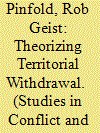

|
|
|
|
|
| Summary/Abstract |
This article examines what factors cause states to withdraw from foreign territorial interventions. Scholarly analyses of withdrawal are rare, whilst within the broader research area of territorial conflict, studies are often dichotomized into neorealist or constructivist-inspired works, emphasizing a select few variables and one level of analysis alone. We argue these excessive simplifications of international politics lack utility for understanding territorial withdrawal. Instead, we employ the principles of strategic theory informed by a Clausewitzian paradigm, and construct a framework of three “arenas of bargaining,” spanning multiple variable-types and levels of analysis, to explain territorial withdrawal. In so doing, the analysis delineates a comprehensible and novel theoretical framework for understanding an under-researched policy problem.
|
|
|
|
|
|
|
|
|
|
|
|
|
|
|
|
| 16 |
ID:
188010


|
|
|
|
|
| Summary/Abstract |
Is there a link between levels of terrorism and the presence of organized crime groups? Which factors does terrorism affect that could impact the presence and expansion of organized crime groups? This study aims to empirically analyze this link. Dealing with potential endogeneity bias using matching methods, we provide quantitative evidence showing that terrorist attacks increase the future levels of organized crime group activities. Using Structural Equation Modeling techniques (SEM), we also show that the main mechanisms through which this relation seems to occur are through the effects of terrorism on state capacity and state legitimacy. Thus, organized crime groups seem to take advantage of the turbulent situation created by terrorist attacks in order to expand their activities. The findings provided in this paper aim to increase our knowledge on the so-called crime-terror nexus.
|
|
|
|
|
|
|
|
|
|
|
|
|
|
|
|
|
|
|
|
|